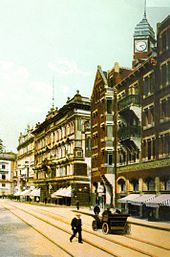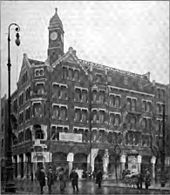Dutch House (Leipzig)
The Dutch House was an office and commercial building in Leipzig , it was located on the southeast side of Augustusplatz on the corner lot Augustusplatz 8 / Johannisgasse 2.
The building, erected between 1901 and 1903, was the only construction carried out in Germany by Hendrik Petrus Berlage , one of the most important Dutch architects at the beginning of the 20th century. His main work is the former Amsterdam stock exchange building , which is known today under the name of Beurs van Berlage , which is characterized by its objectivity and functionality .
Berlage was the preferred architect of the Dutch insurance companies Algemeene Maatschappij van Levensverzekering en Lijfrente (life insurance) and De Nederlanden van 1845 (fire and life insurance). When the Algemeene Maatschappij van Levensverzekering en Lijfrente wanted to open a German branch, they decided on Leipzig as the headquarters of the Dutch life insurance company for Germany . Berlage took over the planning. His design was very close to the construction of the Beurs van Berlage (1896–1903), whose “little sister” is the Dutch House .
The building was defined by clear forms with few decorative elements, the facade was designed in brick, interrupted by granite pillars on the ground floor and lintels made of sandstone on the upper floors. Inside was a light-flooded staircase structured by arcades. The rooms on the ground floor were intended for retail. The construction with modern materials, together with the strict departure from historicism, was initially controversial.
Directly south adjacent which was created at the Dutch house 1928/1929 European House of Otto Paul Burghardt .
After the National Socialists came to power , the entrepreneur Kurt Herrmann acquired the building and made it the headquarters of his company, Architecture and Engineering Office and Property Management Dr.-Ing. Kurt Herrmann , also the auditing department of his universal publisher W. Vobach & Co. - Bernhard Meyer - Curt Hamel and Vobach-Schnitt GmbH were based there. The NS-Gauverlag Sachsen and the Neue Leipziger Tageszeitung were also in the house .
The Dutch house suffered severe damage during World War II. It was canceled in the mid-1950s. Hotel Deutschland (later Interhotel am Ring , now Radisson Blu Hotel ) was opened in its place in 1964 . It extends to the Grimmaischen Steinweg , the Johannisgasse became a dead end.
literature
- Stefan W. Krieg: Disregarded masterpiece. Hendrik Petrus Berlage's insurance construction on Augustusplatz. In: Leipziger Blätter . H. 49, autumn 2006, ISSN 0232-7244 , pp. 16-18, (This article is based on a detailed study of the historical building files).
- Gerhard Nenke: Commercial buildings on Augustusplatz. In: Thomas Topfstedt , Pit Lehmann (Ed.): Der Leipziger Augustusplatz. Functions and shape change of a big city square. Leipziger Universitätsverlag, Leipzig 1994, ISBN 3-929031-28-0 , pp. 59-67.
- Uit Leipzig. Dutch Bouwkunst in Duitschland. In: Onze Kunst. Voortzetting van de vlaamsche School. Volume 2, half year 1, 1903, pp. 112–114 .
Individual evidence
- ^ Counterpoints. Hendrik Petrus Berlage and Erick van Egeraat. Positions of Dutch architecture on Augustusplatz in Leipzig. Joint exhibition of the custody of the University of Leipzig and the Deutscher Werkbund Sachsen e. V. from March 17 to June 3, 2007 in the exhibition center Kroch-Haus Leipzig
- ↑ Address book of the Reichsmesse city Leipzig 1942. Verlag August Scherl Successor, Leipzig 1942
Coordinates: 51 ° 20 ′ 17.1 ″ N , 12 ° 22 ′ 54.7 ″ E


